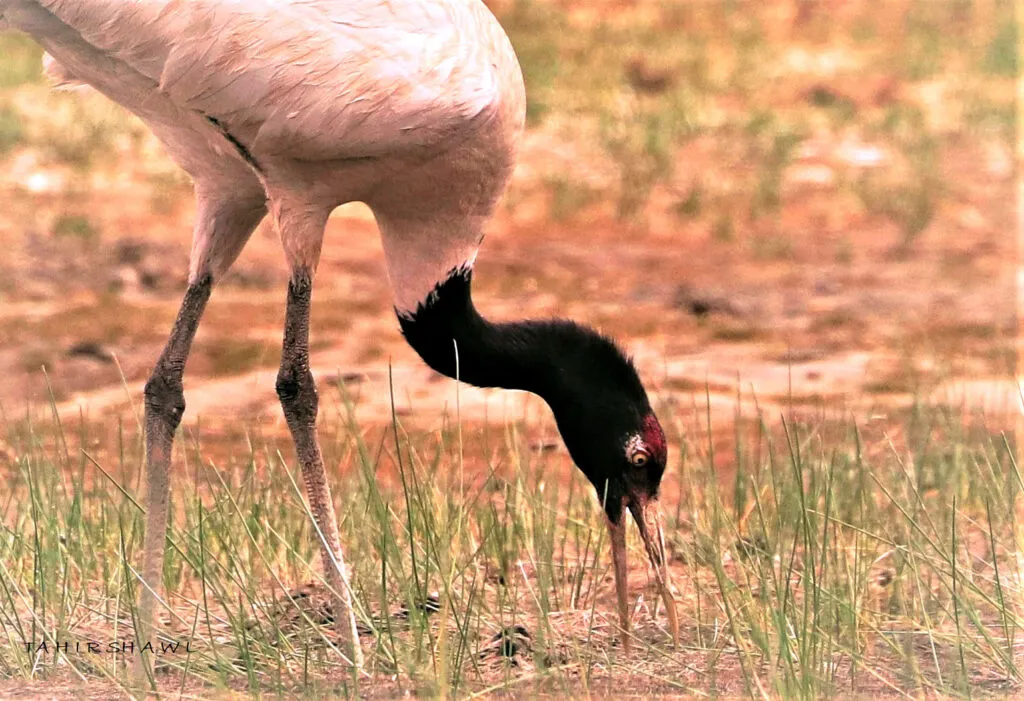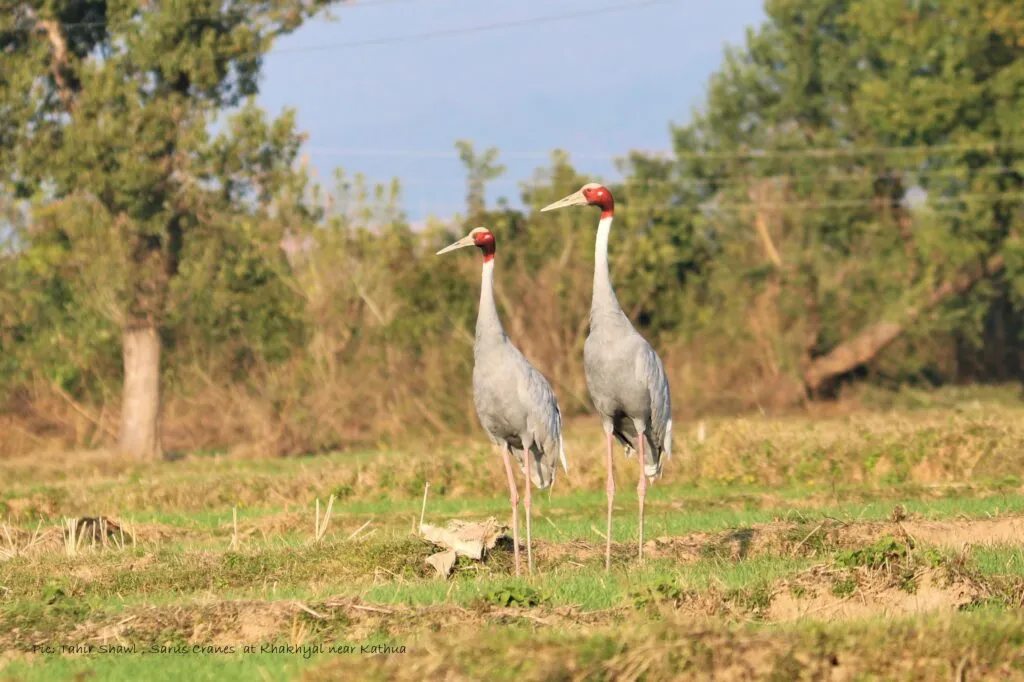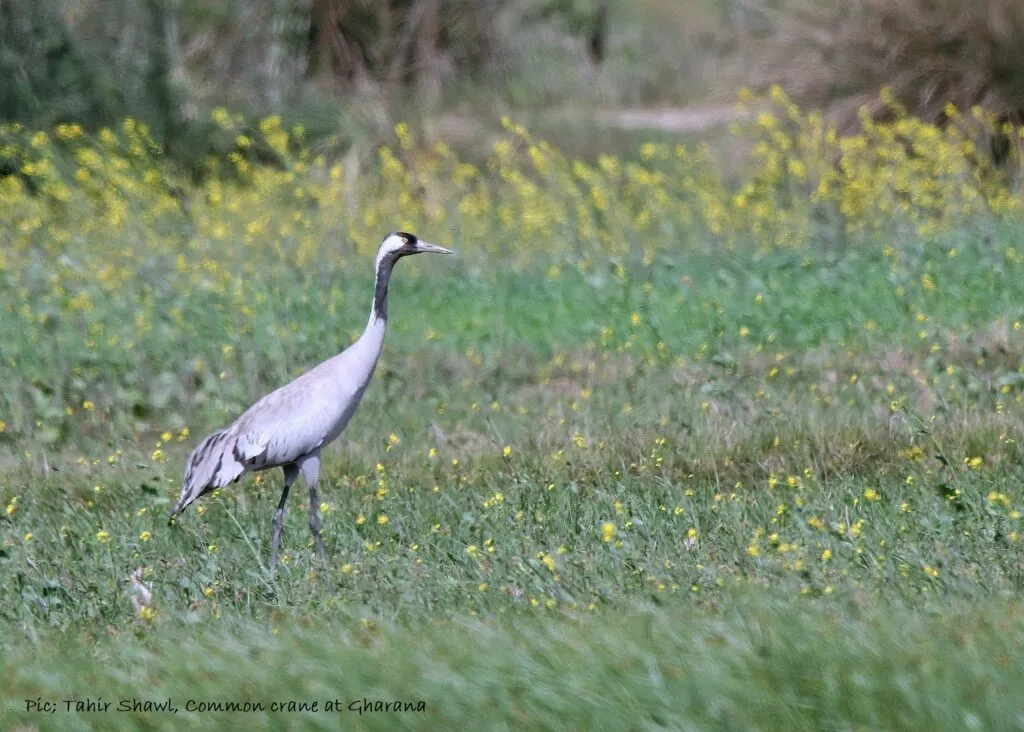May you live as long as the crane is aChinese birthday wish. The reference to crane is because of it’s long life. Cranes are very ancient birds and are among the most endangered bird species on earth. A very small section of people is aware about the cranes found in Jammu & Kashmir and ladakh. This may be true also for most of the other avian species of these regions.
Cranes are beautiful tall birds with very long necks and legs. The Sarus crane is considered to be the largest Indian bird as it stands the height of a man. Fifteen species of cranes are found globally in five continents, except in South America and Antarctica, eleven of them being endangered. India is home to five crane species. However, after the local extinction of Siberian crane only four species now find refuge in India.
Cranes found important place in many cultures and have adored poetry, folksongs, paintings and folklores in many regions. In Dogri, Pahari, Gojri and Kashmiri folksongs cranes found significant references as ‘Koong’ and symbol of beauty and love. Since most of the cranes pair for life they are considered as symbols of fidelity and love.
The erstwhile state of Jammu & Kashmir or the present two union territories viz., Ladakh and Jamu &Kashmir boasting of rich and varied avian diversity are very special in the sense that all the four species of cranes have been reported from here.
Being a wildlifer and nature shutterbug I feel privileged to have seen all the Indian species of cranes visiting the two union territories. The four cranes species which are still seen in our two union territories include Black-necked crane, Sarus crane, Common crane and Demoiselle crane. The Black-necked crane visits high altitude wetlands and marshes in Changthang region of Ladakh during summer while the rest of three species visit Jammu plains in winter some of them being resident.
Records from Kashmir
I am neither aware of any confirm record of the presence of cranes in Kashmir region nor have seen any personally. However, W.R.Lawrence in his book Valley of Kashmir has mentioned ‘Lord Lilford’s Crane’ which is also known as common crane.
The Crane in ladakh : Black-necked crane ( Grus nigricolis)
On the vast expanse of Chushul marshes, near Indo-China border, under the canvas of dark blue sky splashed with strokes of silvery dense clouds, I along with my son, Shoaib, an ardent photography buff teenager, sat silently on the ground by a pool of shimmering water where bar-headed geese, ruddy shell ducks and some other waders were enjoying the morning bask. We, impatiently holding our cameras , while sitting quite silently as in an ambush, waited for our dream bird to get in our range. Our long wait and patience paid. There, in front of us, browsing and moving slowly towards us appeared a pair of black-necked crane. In our utter excitement and joy we watched them clicking our shutters to our fill. Although this was not my first encounter with them I could feel the ecstasy and excitement running through my spine. Every time I see them I enjoy experience the same feelings. My earlier sightings of this crane were at Chushul, Hanle, Loma, Puga, Tsokar, and many other locations in Changthang region of eastern Ladakh which is the only place within Indian limits where black-necked cranes breed. During winter season they visit south west China, Southern Tibet, Bhutan and Arunachal Pradesh in India.

The population of black-necked crane, the state bird of erstwhile J&K state, has dwindled and IUCN has placed it under the threatened category. In Changthang only a few breeding pairs are seen now as they face multiple threatening factors ranging from anthropogenic pressure, habitat destruction, stray and feral dogs and natural predators like fox and wolf. The climate change factors must have taken their toll but need to be studied and researched adequately for proper assessment.
Other cranes viz., Demoiselle crane and Siberian crane have been reported in past from Ladakh as rare vagrant or passage migrant..
The Cranes in Jammu plains:
Sarus Crane (Grus antigone)
The Sarus crane is the tallest flying bird in the world, 5.8 to 6 feet, and stands the height of a man.Owing to its declining population it has been declared Vulnerable by IUCN.
This crane is resident bird in India and breeds in Nepal, Pakistan, and Northern Australia besides northern India. The river beds and khads, marsh areas and cultivations in Vijaypur, Samba, Kathua, Jammu and many other locations provide habitat to Sarus crane in Jammu region.

On a sunny winter morning arriving at a small village, Khokhyal, near Kathua town, the southernmost part of J&K with my small team of enthusiasts, comprising, Pervaiz Shagoo, Shoaib Shawl, Ram, Anshu, a local student, and his father, we dared cross knee-deep chilly streams. Occasionally wading through slush, mud, and walking through agriculture fields laden with sprouting green shoots of wheat and yellow mustard plants we reached our destination in search of Sarus, soaked in wet boots and drenched trousers.
Sighting a pair of Saruscraneswas a solace to eyes. Sitting silently, camouflaged, in cultivation fields, we watched them feeding and occasionally prancing, leaping in the air and bowing in their beautiful dance display while uttering load trumpeting calls. Later in the late afternoon we watched some more of them at other location with their juveniles fluttering wings and taking small flights. As the Sun started disappearing and hiding behind the distant hills the cranes took to wings and we called our day off.
Common Crane (Grus grus) and Demoiselle Crane (Anthropoides virgo)
Demoiselle crane can be distinguished from the Common crane, also known as Eurasian crane, by black front neck feathers extending down the breast and is smaller in size. Both these cranes are winter visitors and are placed under ‘least concerned’ category by IUCN. They visit Jammu plains during winter. The demoiselle crane is considered as vagrant or passage migrant in Jammu and central Ladakh. I have recorded them near Indo-Pak border at Gharana in R.S.Pura and adjoining wetlands.

Siberian Crane (Grus leucogeranus)
Of the five species the only crane which is no more visiting India and is considered as locally extinct is the Sibarian crane. It is critically endangered species and breeds in North east Siberia and Western Siberia where it is now considered as nearly extinct. This crane winters in Iran and Lake Poyang in China. Formerly also a winter visitor to India, mainly in Keoladeo national park, It is no more visiting India after 2002 and is predicted to become globally extinct in near future. I last saw Siberian cranes in 1992 in Keoladeo Ghana National Park in Bharatpur, Rajasthan.
The Siberian crane has been recorded in the past in Jammu & Kashmir, may be as passage visitor or isolated record as literature suggests and is no more seen here.
Keeping the Lifeline Intact
All these crane species are dependent on wetlands, marsh areas, river beds, cultivations including grain and cereal fields. The high altitude marsh lands and wetlands in eastern ladakh are crucial for the survival and breeding of black-necked cranes.
River, Chenab, Tawi and Ravi with their tributaries drain the outer plain of Jammu. Ujh Tarnah and Bein – the major tributaries of Ravi mostly drain the plains of Kathua district. Stretching from the Southern part of Akhnoor , R S Pura, Vijay Pur Samba up to Kathua, bordering Punjab and Himachal states numerous Khads and some small perennial streams and springs interspersed with agriculture fields provide ideal habitat for some of the important avian species including cranes , waders, ducks and geese. Gharana, Abdullian, Sangral Kukrian, and other marshy areas and khads in Vijay Pur, Samba, and Kathua are some of major attractions for these avian species particularly during winter.
These habitats under severe pressure of anthropogenic activity are the lifeline for the survival of our cranes and other species. The posterity and survival of our vanishing cranes depends on the health of their environment and protection of their habitat.






